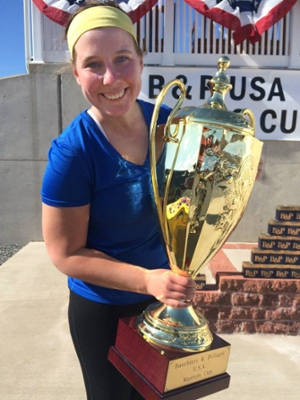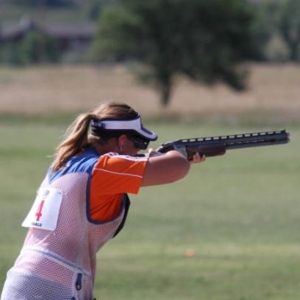 Southern Illinois University Edwardsville freshman Emily Hampson is aiming at some impressive goals. She sees a career in nursing, but before that she has her eyes set on the U.S. Olympic team for shotgun trap.
Southern Illinois University Edwardsville freshman Emily Hampson is aiming at some impressive goals. She sees a career in nursing, but before that she has her eyes set on the U.S. Olympic team for shotgun trap.
The 18-year-old St. Charles, Mo., native is a member of the USA Shotgun National Junior Team. She participated in her first Olympic trials for Olympic trap shooting during October in Tucson, Ariz. In a field of 36 competitors, she finished in the middle of the pack.
“It was incredibly difficult, because the first two days of competition, we had crazy wind, so the targets were flying odd,” Hampson said. “It added a challenge to it, but you can still hit it if you’re in the zone, and you’re focused. Scores were extremely low compared to most competitions. What made the finals wouldn’t ordinarily make the finals in other competitions.
“I wish I would’ve done better, but the experience of shooting in different conditions will be helpful in future competitions where pressure is high.”
Hampson has done well enough to attract Italian gun maker Beretta as a sponsor.
“I was looking for a new gun, because my gun was more for American trap than Olympic,” Hampson explained. “But most Olympic shotguns are really expensive, so my dad (Todd Hampson) pushed me to work toward a sponsorship. I really like Berettas, so I emailed them, sent my resume and told them who I was. We spoke over the phone and worked out a deal for a Beretta DT11.”
Hampson will go to the next Olympic Trial in May in Tiller, Ark. “I got a new custom-made stock for my Beretta,” she said. “It’s longer and lighter, so it changes my swing. I’ve been adjusting and focusing on getting comfortable with it.
“I need to continue with eye exercises during this slower part of the offseason. It is a good time to take a mental break and decompress. I like to read books on the mental game of different sports, like tennis and golf, because much of it is similar.”
Hampson’s interest in shooting was ignited by her dad. As a deer hunter, Todd Hampson thought it was important for Emily and her sisters to know gun safety. He took them to the rifle range and taught them how to properly handle firearms.
“I heard about shotgun shooting, and thought it was exciting and interesting,” she said. “One day, he took me to try American trap-shooting, and I was not good at all, but I loved it!”
“Later, my dad mentioned there were competitions, and we started looking into teams,” she said. “We were told about a local gun club at Busch Shooting Range – the Gateway Clay Busters. We went to an informational meeting that they have annually in December. I started shooting on the team during second semester of my eighth grade year.”
Hampson shot American trap throughout her sophomore year in high school, until a friend introduced her to Olympic trap. As a result, she was shooting both American and Olympic trap during that year.
There is a significant difference between the two types of shooting – American trap has a green trap house above ground with one machine that throws orange clay pigeons at 45 miles per hour at different angles. In Olympic trap, a flat green bunker is level with the shooter’s feet with 15 machines underneath it at different heights and angles. The angles are more challenging, and the machines throw at 75 miles per hour.
There is also a difference in rules – in American trap, a shooter has one shot and shoots at 100 targets with rounds of 25 separated by five-minute breaks.
Olympic competitors get two shots, but one shot in finals. They typically shoot 125 at a competition, but could shoot up to as many as 250, and it could last one day up to four days. Shooters take aim at 25 targets, and then have approximately an hour before the next 25.
“I love Olympic trap,” Hampson said. “It’s more mentally challenging, because if you’re not focusing properly, or you’re distracted and your eyes aren’t in the right place, it has a much greater impact on the outcome.”
 Hampson’s first competition was the 2013 Missouri State Junior Olympics, where she finished second. She won her first match at the 2013 Ohio Regional State Shoot in Fairfield.
Hampson’s first competition was the 2013 Missouri State Junior Olympics, where she finished second. She won her first match at the 2013 Ohio Regional State Shoot in Fairfield.
Hampson points to her work ethic and passion as key to her success. “I put a lot of work into it. I have a drive to continue to improve and get better. I do it for the love of it, not the success.”
Hampson’s training regimen can vary. “During school, I practice as often as I can when I don’t have piles of homework to do,” she said. “If I have time, I’ll meet my dad at the range and work on different skills.
“I do stuff off the range, too, like eye exercises. There’s an app that I use that helps with reaction times. At home, I have a Marsden Ball – it teaches you to focus on a specific area on the ball.”
After winning that first event in Ohio, she decided to focus completely on Olympic trap during junior year of high school. She wanted to work on improving and putting all her effort into one sport.
Hampson went to the Missouri Junior Olympics again, and won, and repeated as champion in the Ohio event. She went to the 2014 Junior Olympics in Colorado Springs for the first time, and placed third in her age category.
She shot Scholastic Clay Target Program (SCTP) in the 2014 nationals in Olympic style in Colorado and made her first senior ladies finals. She finished third. “There was more pressure, because there was a lot more people there than in previous competitions,” she said.
One of the great influences in Hampson’s shooting career is Craig Hancock, father of Olympic skeet shooter Vincent Hancock. “Craig helped improve my shooting, what to focus on and my mental game,” she said.
“He told me about the Marsden Ball. We discussed the path to the Olympics, and he made it seem like a plausible goal. We talked about setting goals – for practice, for competition – focus on the smaller goals, and eventually we’ll get there.
“Focus on the process, the journey, because you’re going to have ups and downs. At the end of the day, you just have to push through it and believe in yourself. He improved my confidence with that.”
A step-by-step process is mandatory in order to make the Olympic team. First, an individual needs a minimum qualifying score (MQS). To get an MQS, a shooter has to compete in a World Cup event that’s regulated by the International Shooting Sports Federation (ISSF).
To get to World Cup event, a competitor needs to be invited by USA Shooting. Once a person shoots an MQS, he or she is eligible to possibly go to the Olympics. Hampson’s first World Cup was March 2015 when she went to Acapulco, Mexico and earned an MQS.
At the beginning of senior year in high school, Hampson shot in the fall Olympic selection match in Tiller, Ark. “I finished as one of the top junior ladies,” she said. “That was my first selection match, so that was exciting. The following few months after my showing in Arkansas, I got an email inviting me to the World Cup in Mexico.”
Hampson chose SIUE partly because it’s only 30 minutes from her shooting range. “There are not a lot of places you can shoot Olympic trap in U.S., maybe 50 ranges, and none in Illinois,” she said. “So, I drive to Missouri to shoot.
“I liked the School of Nursing and got direct entry, which played a big factor in my choice,” she said. “As someone who travels and is gone for competitions, I miss a lot of school, so to be guaranteed a spot in the nursing program is key.”
Hampson’s 2015 season has been particularly busy and successful. She won the SCTP National Championship, the USAS Junior Olympic Championship and the Missouri State Junior Olympics. She also won the Junior World Cup in Suhl, Germany.
“If I have to, I take homework with me, but when we were in Lonato, Italy for the World Championships, we had only been in school for two weeks. I took a lot of work with me, but we didn’t have Internet there, and I couldn’t do online homework. So, my professors gave me alternate assignments. They’ve been great working around my schedule, and I’m thankful for that.”
Hampson didn't make the finals in Italy, but the trio representing the U.S. junior ladies team took bronze.
Hampson’s long-term goal is to become a nurse practitioner, but she’s not sure about a specialization just yet. She graduates in 2019 and hopes to take a year off to train for the 2020 Olympics before looking for that first job.
Photo: Emily Hampson shooting; and holding the trophy from the USA B&P Masters Cup in Pennsylvania in April, 2015 where she won high overall.